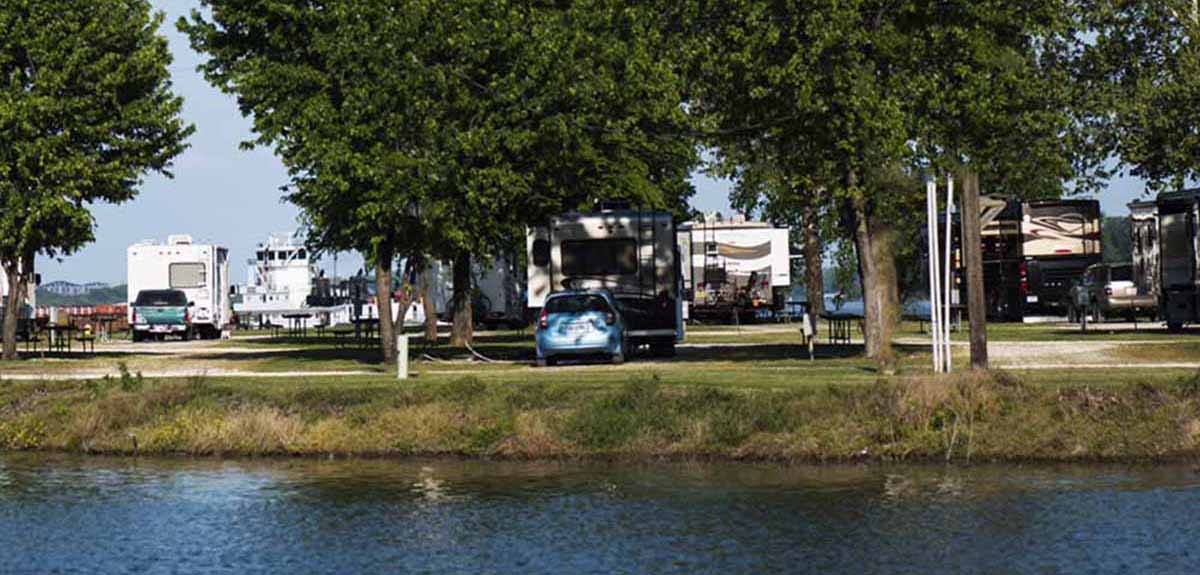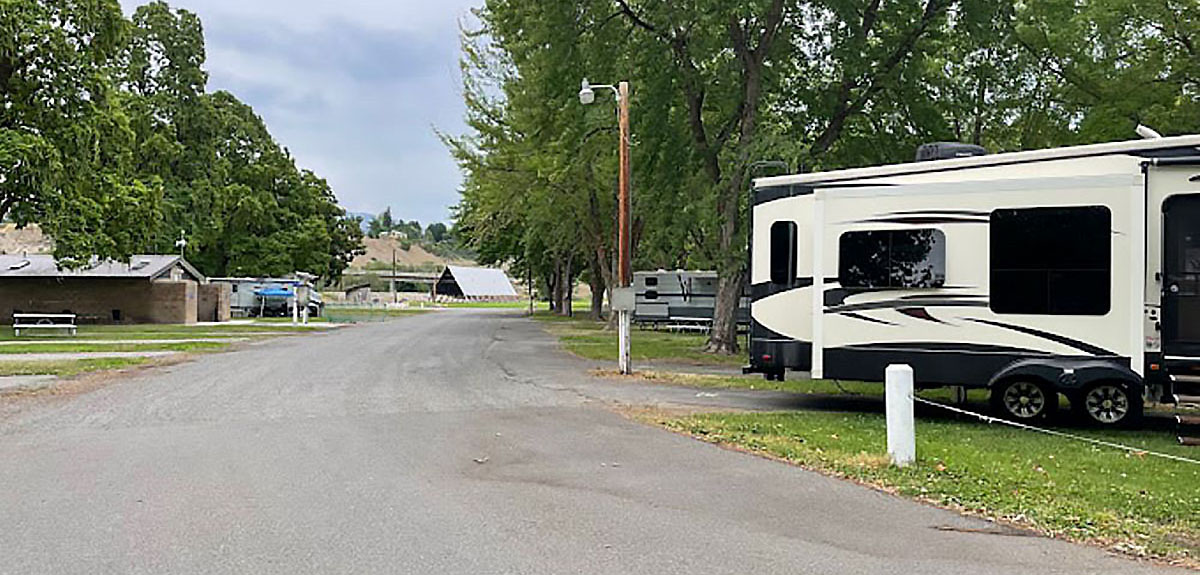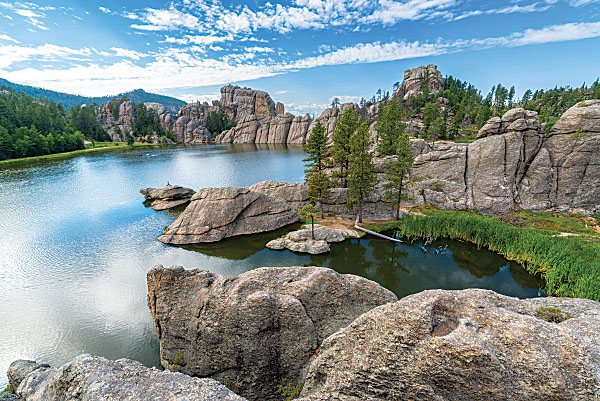Winter Camping in the Snow
Image Caption:
Winter camping has its own special beauty, and for a growing number of RV enthusiasts this brisk season no longer means packing up the rig for months of storage every year. However, even the hardiest of humans finds it a challenge to be comfortable in a blizzard. Fortunately, there are dozens of travel trailers equipped with frigid-temperature insulation packages to help occupants as well as components weather the winter climates they may want to venture into.
These may include standards or options such as double-pane windows, insulated water lines and valves, and insulated and/or heated water and holding tanks. Some trailers old and not-so-old may not be so lucky. They require special preparation because they were not specially designed for below-freezing weather. Here are a few tips that can help prepare any trailer for that next winter destination.
Power
Access to power such as an electrical hookup would make cold-weather camping toasty, but that’s not always going to happen, so be ready to rely on batteries and generators. Power requirements can be handled by an AC generator, a good set of “house batteries” — a total of at least 210-amp hours (350 minutes of reserve capacity at the 25-amp rate) — and a better electrical converter than is found in most trailers. A top-notch electrical converter is a key component here. Most standard converters perform well on the power-supply side. But during winter, you need multistage charging.
If your unit carries a multistage charger that can produce at least 14.2 volts during a bulk charge phase (see your RV literature), then you are good. If not, then look into multistage chargers such as the Iota DLS 75 Smart Charger or Xantrex TrueCharge2. Check the Internet for retail sources and other similar products. Other similar multistage high-output chargers are also suitable. Rapid battery recharging while running the generators less is the ultimate goal.
Compact portable generators such as the Yamaha EF2000iS or Honda EU2000iA 2000-watt units are amazingly quiet and can operate charging units such as Iota’s DLS 75, as well as other 12-volt DC toys such as a TV, computer or DVD player.
Keep Water Lines Warm
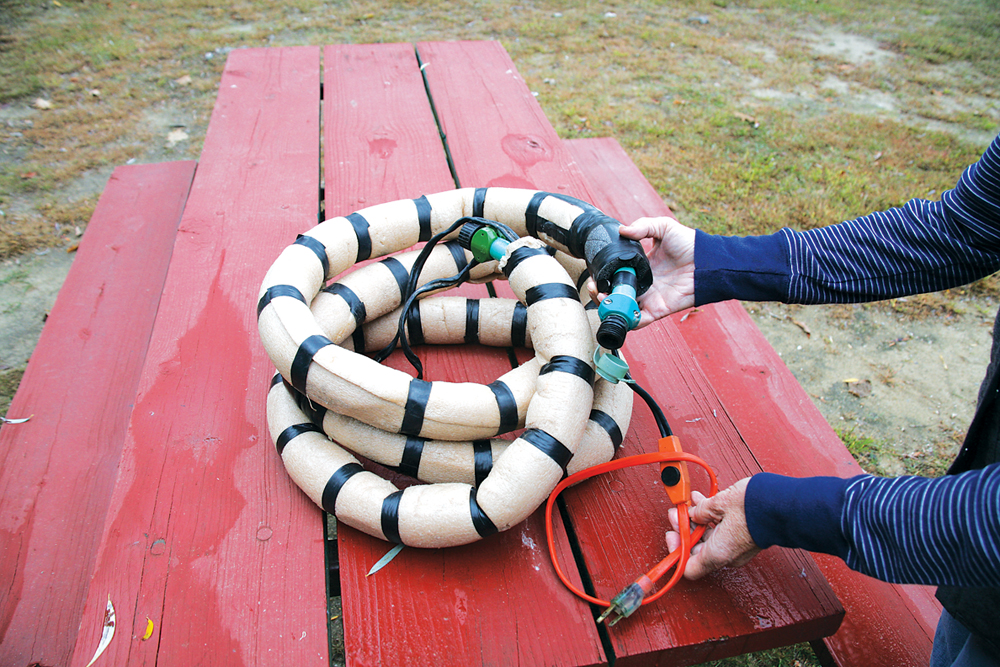
Wrapping hoses with heat tape and insulation is a good way to keep water supplies open
You can winterize your trailer and lock it behind a fence for the season, but that defeats the purpose of owning it for about one-third of the year in some parts of the country, or venturing into certain parts of the country during winter.
Protection against freezing is important because burst pipes lead to expensive and rather inconvenient repairs. In order to evaluate your trailer’s winter capability, you should inspect water line routing from the inside and out, or in the basement. All of the pipes should be exposed to the heated interior of the RV. It’s not necessary to keep the lines hot, but they need to be warmer than 32 degrees F.
Warm air circulation to the inner recesses of the RV can be improved sometimes through additional air vents. Beyond that, additional insulation may be needed to reduce the rate of heat loss, especially in outside compartments where tank valves and water lines are located. Water in drainpipes usually will not freeze because water does not typically stand inside them.
Several types of insulation are effective in various applications and are available at building supply, hardware and automotive supply stores:
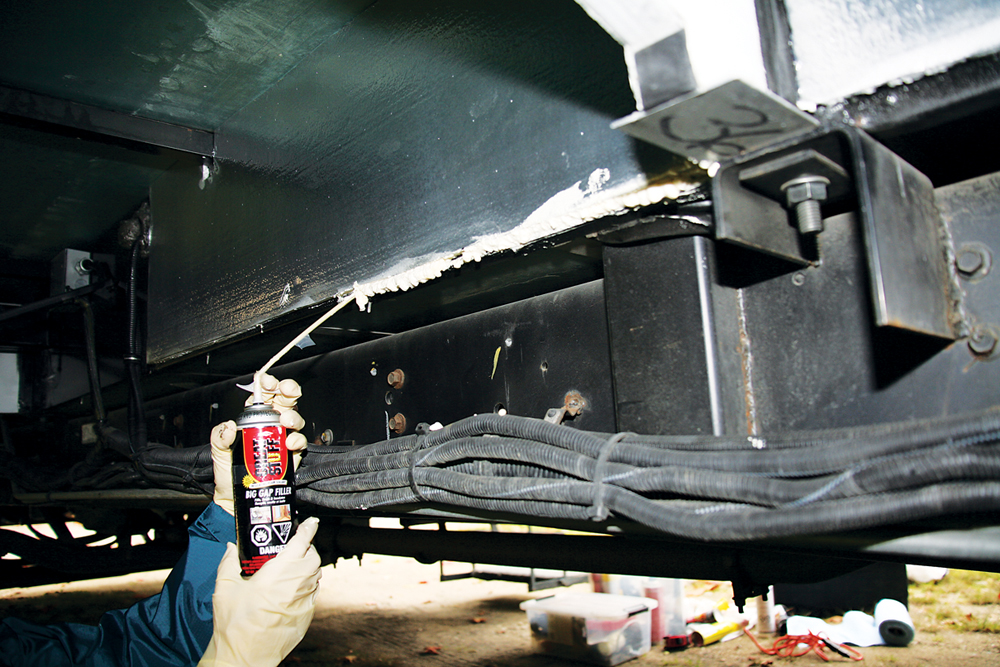
Polyurethane foam can be used to spot-insulate drafty areas.
Types of Insulation
- Regular old-fashioned fiberglass batting (the pink kind) is good for packing into basements and compartments that are not all that well insulated, but don’t let fiberglass get wet.
- Polyurethane-foam spray such as Great Stuff Big Gap Sealer by Dow will expand when it exits from the nozzle of the can and can effectively seal corners and gaps, and can be shaped and formed like putty.
- Bubble insulation (such as Reflectix or Prodex brands) are made up of thousands of small bubbles in a plastic mesh covered in a foil sandwich. It is reflective and has insulating qualities. It can be attached with contact cement to almost any surface.
- Foil-covered styrene Fome-Cor Board can be used to further insulate interior or exterior storage cabinets using spray adhesive to attach the board to the walls of the compartments.
- Spray exterior tanks and undercarriage structures with automotive undercoating to further protect them from winter road elements, ice, snow and water.
If they are just too isolated from heat, holding tank valves in a vented compartment can be freeze-protected with the low heat of a 60- or 100-watt incandescent light bulb, if you have shorepower. Heating pads and other specialized heating elements for such purposes are also available, but lacking something more sophisticated, the light bulbs may do the trick. If dump-valve protection is simply not available, you can protect them by pouring a gallon or two of RV non-toxic or low-temperature windshield washer fluid (not for use in potable water systems) into each holding tank prior to the trip. The proportion will vary with ambient temperature and the amount of the fluid already in the tank, but even if the tank valves are protected with anti-freeze, the bathroom compartment needs to be insulated and heated if the water lines extend into it or they will freeze. Anti-freeze should also be used in the P-traps that are not within heated areas. If you have an icemaker, it should be disconnected and winterized.
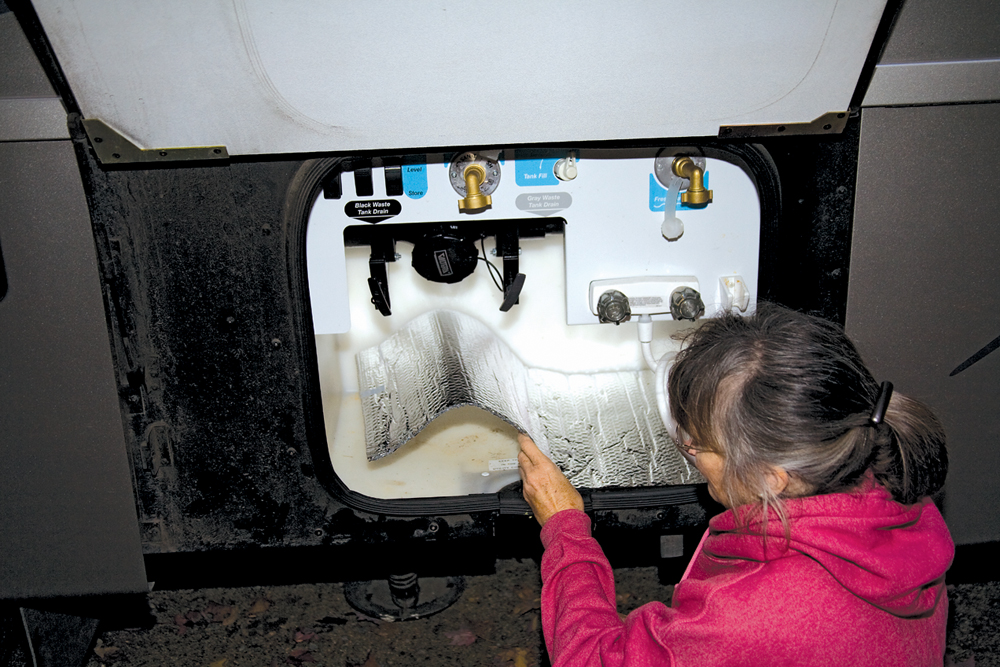
Reflective insulation can be used in compartments.
Above and beyond additional insulation, there are electrical heating pads for holding tanks, pipes and water lines that can be very effective. The better heaters, such as those available from UltraHeat, come in a variety of sizes and are thermostatically controlled (not activated until the ambient temperature reaches 44 degrees F). Look for models offered for 12-volt DC and/or 120-volt AC power sources; that way they can be used when hooked up to shorepower, or when boondocking.
Insulating. Slides, Windows and Doors
A few late-model high-end trailers, especially those with “cold-weather packages” have double-pane, gas-filled or purged windows that are far better insulators than single-pane windows. You can use storm-window kits, basically clear plastic sheets stretched over windows with the edges taped to the window frames then made tight with a heat gun or hair dryer, in some situations to improve the heat-retention qualities of your trailer’s windows if necessary. These kits can usually be found in hardware and home improvement stores. (Note: A hair drier is a handy tool to have around during winter RV travel for emergency pipe defrosting.)
The doors in trailers often have less insulation than walls and single-pane windows, so they are good places to add more insulation when getting prepared for winter destinations. Bubble-type insulation and Fome-Cor Board are good ideas here.
Most trailers have slideouts these days, and it’s necessary to prevent the buildup of ice and snow on top of these slideouts or on the awnings. This may mean retracting slideouts and awnings during a snowstorm, especially heavily blowing snow, or having to clean snow off the top before it turns to ice.
Portable Catalytic Heat
Portable catalytic heaters can dramatically improve your comfort and are offered by a number of manufacturers such as Coleman, SportCat and Heat Buddy in output range up to 18,000 Btu. Some of these heaters can operate independently using a portable gas source or be connected to the trailer’s LP-gas system. Camco’s Olympian Wave Catalytic Safety Heater is popular among RV enthusiasts and can be used portably or installed inside the RV, as long as clearance requirements are met.
Catalytic heaters don’t normally require connection to a 12-volt DC electrical source, although some models do, which drains the battery when boondocking. They are very efficient at producing heat but produce a flame, creating radiant heat by combining oxygen with propane inside the catalyst pad.
The catalytic heaters are not approved by RVIA for installation in new RVs due to fact that the organization’s building code requires outside venting of heaters and furnaces — but not gas stoves. Unvented catalytic heaters consume small amounts of oxygen (during combustion) from inside the RV, and produce very small amounts of carbon monoxide, resulting in a recommendation by all heater manufacturers that a window or vent be left partially open. Ventilation is absolutely needed anyway to relieve condensation levels that increase with the use of a catalytic heater. And all newer RVs have CO detectors, which should be tested regularly, as well. It’s very important to avoid using unvented flame-producing heat sources of any kind inside a trailer, other than the occasional stove or oven for cooking.
Winter RVing can present some interesting challenges. However, for those who are up for it, and enjoy getting out instead of sitting on the couch, these tips and a little hard work can stretch the travel season and make year-round adventures on the road a reality.
Sources:
The Coleman Company
800-835-3278, www.coleman.com
Dow Chemical Company
800-258-2436, greatstuff.dow.com
American Honda Company
770-497-6400, www.honda.com
IOTA Engineering
520-294-3292, www.iotaengineering.com
Prodex
720-733-1661, www.insulation4less.com
Reflectix Inc.
800-879-3645, www.reflectixinc.com
US Catalytic (Camco Manufacturing)
800-334-2004, uscatalytic.com
Yamaha Motor Corp., USA
800-962-7926,www.yamaha-motor.com
Xantrex Technology, Inc.
800-446-6180, www.xantrex.com
“

